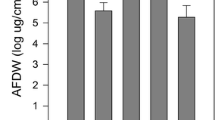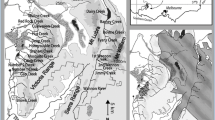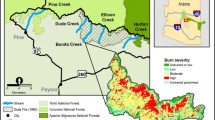Abstract
Large and severe wildfires can dramatically alter terrestrial and aquatic ecosystems. We documented changes in benthic macroinvertebrate communities and physical habitat at two sites along Angora Creek, CA, USA for 2 years following a severe fire. Although post-fire years had low precipitation, canopy cover and bank stability declined dramatically following the wildfire (canopy cover: 88% pre-fire, 22% post-fire; stable bank: 93% pre-fire, 11% post-fire). Substrate also changed substantially, with fine sediment 8× more abundant post-fire and cobble 7× less abundant post-fire. We found no consistent changes in taxonomic richness or diversity following the fire, but post-fire densities and percentage of sensitive taxa were significantly reduced. We observed large reductions in relative abundances of shredder and scraper taxa, while collector-gatherer abundances increased. Community composition shifted away from pre-fire configurations, and continued to diverge in the second year following the fire. Scores from a regionally derived index of biotic integrity (IBI) were variable but overall much lower in post-fire samples and did not show recovery after 2 years. Overall, our study demonstrated substantial post-fire effects to aquatic ecosystems even in the absence of large flooding or scouring events, and showed that these effects can be transmitted downstream into unburned reaches.





Similar content being viewed by others
References
Barbour, M. T., J. Gerritsen, B. D. Synder & J. B. Stribling, 1999. Rapid bioassessment protocols for use in streams and wadeable rivers: periphyton, benthic macroinvertebrates, and fish. Second edition. EPA 841-B-99-002. U.S. Environmental Protection Agency, Office of Water, Washington, D.C.
Covington, W. W., R. L. Everett, R. W. Steele, L. I. Irwin, T. A. Daer & A. D. Auclair, 1994. Historical and anticipated changes in forest ecosystems in the Inland West of the United States. Sustainable Forestry 2: 13–63.
Drake, J. A., 1984. Species aggregation: the influence of detritus in a benthic invertebrate community. Hydrobiologia 112: 109–115.
Earl, S. R. & D. W. Blinn, 2003. Effects of wildfire ash on water chemistry and biota in south-western U.S.A. streams. Freshwater Biology 48: 1015–1030.
Gresswell, R. E., 1999. Fire and aquatic ecosystems in forested biomes of North America. Transactions of the American Fisheries Society 128: 193–221.
Hall, S. J. & D. Lombardozzi, 2008. Short-term effects of wildfire on montane stream ecosystems in the Southern Rocky Mountains: one and two years post-burn. Western North American Naturalist 68: 453–462.
Hawkins, C. P. & J. R. Sedell, 1981. Longitudinal and seasonal changes in functional organization of macroinvertebrate communities in four Oregon streams. Ecology 62: 387–397.
Herbst, D. B. & E. L. Silldorff, 2009. Development of a benthic macroinvertebrate index of biological integrity (IBI) for stream assessments in the eastern Sierra Nevada of California. Report to the Lahontan Regional Water Quality Control Board. http://www.waterboards.ca.gov/lahontan/water_issues/programs/swamp/docs/east_sierra_rpt.pdf. Accessed on 21 Feb 2010.
Jackson, B., K. Sullivan & S. Mazeika, 2009. Influence of wildfire severity on riparian plant community heterogeneity in an Idaho, USA wilderness. Forest Ecology and Management 259: 24–32.
Lindenmayer, D. B., G. E. Likens & J. F. Franklin, 2010. Rapid responses to facilitate ecological discoveries from major disturbances. Frontiers in Ecology and the Environment 10: 527–532.
Malison, R. L. & C. V. Baxter, 2010. Effects of wildfire on varying severity on benthic stream insect assemblages and emergence. Journal of the North American Benthological Society 29: 1324–1338.
McCune, B. & M. J. Mefford, 2006. PC-ORD, Multivariate Analysis of Ecological Data. Version 5.10, MjM Software, Gleneden Beach, Oregon, USA.
McGeoch, M. A., 1998. The selection, testing, and application of terrestrial insects as bioindicators. Biological Reviews of the Cambridge Philosophical Society 73: 181–201.
Mielke, P. W. Jr., K. J. Berry & G. W. Brier, 1981. Application of multi-response permutation procedures for examining seasonal changes in monthly sea-level pressure patterns. Monthly Weather Review 109: 120–126.
Mihuc, T. B. & G. W. Minshall, 1995. Trophic generalists versus trophic specialists: implications for food web dynamics in post-fire streams. Ecology 76: 2361–2372.
Mihuc, T. B., G. W. Minshall & C. T. Robinson, 1996. Response of benthic macroinvertebrate populations in Cache Creek, Yellowstone National Park to the 1988 wildfires. In Greenlee, J. M. (ed.), The Ecological Implications of Fire in Greater Yellowstone. International Association of Wildland Fire, Fairfield, WA: 83–94.
Miller, J. D., E. E. Knapp, C. H. Key, C. S. Skinner, C. J. Isbell, R. M. Creasy & J. W. Sherlock, 2009. Calibration and validation of the relative differenced Normalized Burn ratio (RdNBR) to three measures of fire severity in the Sierra Nevada and Klamath Mountains, California, USA. Remote Sensing of Environment 113: 645–656.
Minshall, G. W., 2003. Responses of stream benthic macroinvertebrates to fire. Forest Ecology and Management 178: 155–161.
Minshall, G. W., C. T. Robinson & D. E. Lawrence, 1995. Postfire response of lotic ecosystems in Yellowstone National Park, U.S.A. Canadian Journal of Fisheries and Aquatic Sciences 54: 2509–2525.
Minshall, G. W., J. T. Brock, D. E. Andrews & C. T. Robinson, 2001a. Water quality, substratum and biotic responses of five central Idaho USA streams during the first year following the Mortar Creek fire. International Journal of Wildland Fire 10: 185–199.
Minshall, G. W., C. T. Robinson, D. E. Lawrence, D. A. Andrews & J. T. Brock, 2001b. Benthic macroinvertebrate assemblages in five central Idaho (USA) streams over a 10-year period following disturbance by wildfire. International Journal of Wildland Fire 10: 201–213.
Minshall, G. W., T. V. Royer & C. T. Robinson, 2001c. Response of the Cache Creek macroinvertebrates during the first 10 years following disturbance by the 1988 Yellowstone wildfires. Canadian Journal of Fisheries and Aquatic Sciences 58: 1077–1088.
Murphy, K., T. Rich & T. Sexton, 2007. An assessment of fuel treatment effects on fire behavior, suppression effectiveness, and structure ignition on the Angora Fire. Report R5-TP-025, USDA Forest Service, Pacific Southwest Region, Vallejo, CA.
Oliver, A. A., J. E. Reuter, A. C. Heyvaert & R. A. Dahlgren, 2011. Water quality response to the Angora Fire, Lake Tahoe, California. Biogeochemistry. http://www.springerlink.com/content/v503347l66318240/.
Pettit, N. E. & R. J. Naiman, 2007. Fire in the riparian zone: characteristics and ecological consequences. Ecosystems 10: 673–687.
Poff, N. L., 1997. Landscape filters and species traits: towards mechanistic understanding and prediction in stream ecology. Journal of the North American Benthological Society 16: 391–409.
Resh, V. H. & D. M. Rosenberg, 1989. Spatial-temporal variability and the study of aquatic insects. Canadian Entomologist 121: 941–963.
Reynoldson, T. B., R. H. Norris, V. H. Resh, K. E. Day & D. M. Rosenburg, 1995. The reference condition: a comparison of multimetric and multivariate approaches to assess water quality impairment using benthic macroinvertebrates. Journal of the North American Benthological Society 16: 833–852.
Rinne, J. N., 1996. Short-term effects of wildfire on fishes and aquatic macroinvertebrates in the southwestern United States. North American Journal of Fisheries Management 16: 653–658.
Roby, K. B. & D. L. Azuma, 1995. Changes in a reach of a Northern California stream following wildfire. Environmental Management 19: 591–600.
Rosenburg, D. M. & V. H. Resh, 1993. Freshwater biomonitoring and benthic macroinvertebrates. Chapman and Hall, London.
Safford, H. D., D. A. Schmidt & C. H. Carlson, 2009. Effects of fuel treatments on fire severity in an area of wildland-urban interface, Angora Fire, Lake Tahoe Basin, California. Forest Ecology and Management 258: 773–787.
Stubblefield, A. P., J. E. Reuter, R. A. Dahlgren & C. R. Goldman, 2007. Use of turbidometry to characterize suspended sediment and phosphorus fluxes in the Lake Tahoe basin, California, USA. Hydrological Processes 21: 281–291.
Townsend, C. R., 1989. The patch dynamics concept of stream community ecology. Journal of the North American Benthological Society 8: 36–50.
Turner, M. G., W. L. Baker, C. J. Peterson & R. K. Peet, 1998. Factors influencing succession: lessons from large, infrequent, natural disturbances. Ecosystems 1: 511–523.
USFS (USDA Forest Service), 2007. Angora Incident Initial BAER Report. Lake Tahoe Basin Management Unit, South Lake Tahoe, CA.
Vieira, N. K. M., W. H. Clements, L. S. Guevara & B. F. Jacobs, 2004. Resistance and resilience of stream insect communities to repeated hydrologic disturbances after a wildfire. Freshwater Biology 49: 1243–1259.
Westerling, A. L., H. G. Hidalgo & T. W. Swetnam, 2006. Warming and earlier spring increase western U.S. forest wildfire activity. Science 313: 940–943.
White, P. S. & S. T. A. Pickett, 1985. Natural disturbance and patch dynamics, an introduction. In Pickett, S. T. A & P. S. White (eds), The Ecology of Natural Disturbance and Patch Dynamics. Academic Press, New York, USA: 3–13.
Acknowledgments
The authors would like to extend personal thanks to Raina Patriocinio, Christopher Springer, and Eric Holmes for personal assistance with data collection, and the Lahontan Regional Water Quality Control Board for generously providing laboratory space. We thank the Kearney Foundation of Soil Science, UC Davis Graduate Group in Ecology Block Grant, Jastro Shields Fellowship, Lahontan Regional Water Quality Control Board, and California SWAMP for financial support.
Author information
Authors and Affiliations
Corresponding author
Additional information
Handling editor: Sonja Stendera
Rights and permissions
About this article
Cite this article
Oliver, A.A., Bogan, M.T., Herbst, D.B. et al. Short-term changes in-stream macroinvertebrate communities following a severe fire in the Lake Tahoe basin, California. Hydrobiologia 694, 117–130 (2012). https://doi.org/10.1007/s10750-012-1136-7
Received:
Revised:
Accepted:
Published:
Issue Date:
DOI: https://doi.org/10.1007/s10750-012-1136-7




